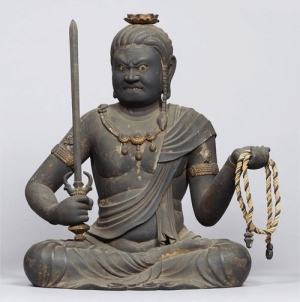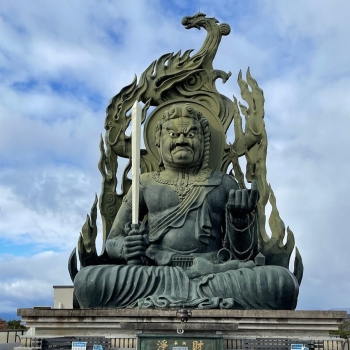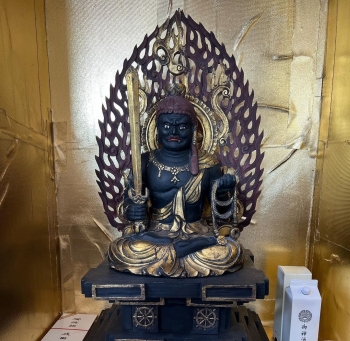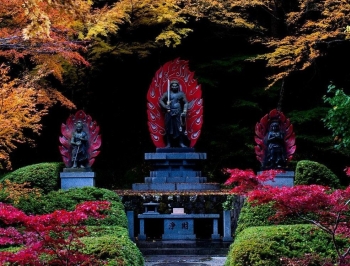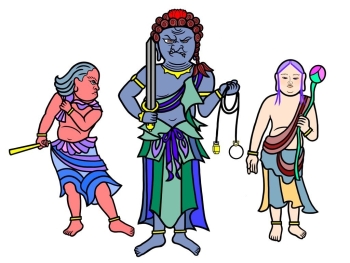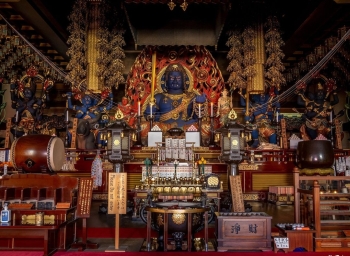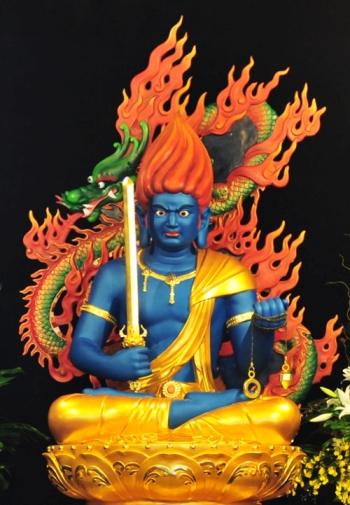Acala | Fudō Myōō
Acala | Fudō Myōō
Acala or Achala (Sanskrit: The Immovable
), also known as Acalanātha (Immovable Lord
) or Āryācalanātha (Noble Immovable Lord
), is a wrathful deity and Dharmapāla (protector of the Dharma) prominent in Vajrayāna Buddhism and East Asian Buddhism.
Currently it is most popular in Japanese Buddhism as Fudō Myōō:
It is believed this figure was introduced in Japan by the founder of Shingon Buddhism Kūkai, who brought the teachings of Esoteric Buddhism from China in 805.
Originally a minor deity described as a messenger or acolyte of the Buddha Vairocana, Acala later rose to prominence as an object of veneration in his own right
- as a remover of obstacles and destroyer of evil, eventually becoming seen as the wrathful manifestation of Vairocana, the Buddha Akṣobhya, or the bodhisattva Mañjuśrī.
In later texts, he is also called Caṇḍaroṣaṇa (Violent Wrathful One
) or Caṇḍamahāroṣaṇa (Violent One of Great Wrath
), the names by which he is more commonly known in countries like Nepal and Tibet.
In East Asian esoteric Buddhism, Acala is classed among the Wisdom Kings (Vidyārāja) and is preeminent among the 5 Wisdom Kings of the Womb Realm. Accordingly, he occupies an important hierarchical position in the Mandala of the Two Realms.
In China, he is known as Bùdòng Míngwáng (Immovable Wisdom King
, the Chinese translation of Sanskrit Acala Vidyārāja), while in Japan, he is called Fudō Myōō.
Acala (as Fudō) is one of the especially important and well-known divinities in Japanese Buddhism, being especially venerated in the Shingon, Tendai, Zen, and Nichiren sects, as well as in Shugendō.
Acala has been worshipped throughout the Middle Ages and into modern times in Nepal, Tibet, China and Japan, where sculptural and pictorial representations of him are most often found.
Origins and development
Acala first appears in the Amoghapāśakalparāja Sūtra (translated in Chinese by Bodhiruci circa 707-709 CE), where he is described as a servant or messenger of the Buddha Vairocana:
-The first from the West in the Northern Quadrant is the acolyte Acala.
-In his left hand he grasps a noose and in his right hand he holds a sword. He is seated in the half-lotus position.
Amoghapāśakalparāja Sūtra
More well-known, however, is the following passage from the Mahāvairocana Tantra which refers to Acala as one of the deities of the Womb Mandala:
Below the lord of mantras i.e. Vairocana, in the south-western direction, is Acala, servant of the Tathāgata.
He holds the sword of wisdom and the noose (pāśa). His hair hangs on his left shoulder. One eye lightly squinting, he gazes intently.
Blazing flames radiate from his awe-inspiring body. He dwells on a large rock. On his forehead are wrinkles like waves on the water. He is a young boy with a plump body.
Mahāvairocana Tantra
The deity was apparently popular in India during the 8-9th centuries as evident by the fact that 6 of the Sanskrit texts translated by the esoteric master Amoghavajra into Chinese are devoted entirely to him.
Some scholars have put forward the theory that Acala originated from the Hindu god Śiva, particularly his attributes of destruction and reincarnation.
Acala is said to be a powerful deity who protects the faithful by burning away all impediments (antarāya) and defilements (kleśa), thus aiding them towards enlightenment.
In a commentary on the Mahāvairocana Tantra by Yi Xing, he is said to have manifested in the world following Vairocana's vow to save all beings, and that his primary function is to remove obstacles to enlightenment.
Indeed, the tantra instructs the ritual practitioner to recite Acala's mantras or to visualize himself as Acala in order to remove obstacles.
From a humble acolyte, Acala evolved into a powerful demon-subduing deity.
In later texts such as the Caṇḍamahāroṣaṇa Tantra, Acala - under the name Caṇḍaroṣaṇa (Violent Wrathful One
) or Caṇḍamahāroṣaṇa (Violent One of Great Wrath
)
- is portrayed as the frightener of gods, titans, and men, the destroyer of the strength of demons
who slays ghosts and evil spirits with his fierce anger.
In the Sādhanamālā, the gods Vishnu, Śiva, Brahma and Kandarpa - described as wicked
beings who subject humanity to endless rebirth - are said to be terrified of Acala because he carries a rope to bind them.
In Tibetan Buddhism, Acala or Miyowa is considered as belonging to the Vajrakīla (vajra family
), a category of deities presided over by the Buddha Akṣobhya and may even be regarded, along with the other deities of the kīla, as an aspect or emanation of the latter.
Indeed, he is sometimes depicted in South Asian art wearing a crown bearing an effigy of Akṣobhya.
In Nepal, Acala may also be identified as a manifestation of the bodhisattva Mañjuśrī.
By contrast, the Sanrinjin (bodies of the 3 wheels
) theory prevalent in Japanese esoteric Buddhism (Mikkyō) interprets Acala as an incarnation of Vairocana.
In this theory, the 5 chief Vidyārājas or wisdom kings (Myōō), of which Acala is one, are interpreted as the wrathful manifestations (kyōryōrin-shin, lit. embodiments of the wheel of injunction
) of the 5 Tathāgatas,
who assume the form of gentle Bodhisattvas to teach the Dharma to sentient beings and terrifying Wisdom Kings to subdue and convert hardened nonbelievers.
Under this conceptualization, the Wisdom Kings are ranked superior to the Dharmapāla, a different class of guardian deities.
Texts
As noted above, Acala appears in the Amoghapāśakalparāja Sūtra and the Mahāvairocana Tantra (also known as the Mahāvairocana Abhisaṁbodhi Tantra or the Vairocana Sūtra).
As Caṇḍaroṣaṇa or Caṇḍamahāroṣaṇa, he is the primary deity of the Caṇḍamahāroṣaṇa Tantra and is described in the Sādhanamālā.
The Japanese Esoteric Buddhist tradition and Shugendō also make use of the following apocryphal sūtras on Acala:
1. Sūtra of the Great Wrathful King Āryācala's Secret Dhāraṇī:
This is a sūtra in the form of a discourse given by the bodhisattva Vajrasattva (identified here with Samantabhadra) to Mañjuśrī concerning Acala's nature.
Acala, identified in this text with the all-pervading dharmakāya, is here said to have no fixed abode, but dwells within the hearts of sentient beings
.
2. Āryācala Sūtra:
This is a condensed version of the above sūtra. To this text is often appended 2 litanies of the names of Acala's young acolytes (dōji), the '36 dōji' (sanjuroku dōji) and the '8 great dōji' (hachi daidōji).
3. Sūtra on Reverencing the Secret Dhāraṇī of Āryācala
Bījā and mantra
The bīja or seed syllables used to represent Acala in Japanese Buddhism are Hāṁ (हां) and Hāmmāṁ (हाम्मां), the latter being a combination of the 2 final bīja in his mantra: Hāṁ Māṁ (हां मां).
Hāṁ is sometimes confounded with the similar-looking Hūṁ (हूं), prompting some writers to mistakenly identify Acala with other deities.
3 mantras of Acala are considered to be the standard in Japan:
The most widely known one, derived from the Mahāvairocana Tantra and popularly known as the Mantra of Compassionate Help
(jikushu or jikuju), goes as follows:
Sanskrit
Namaḥ Samanta Vajrānāṁ Caṇḍa-mahāroṣaṇa Sphoṭaya Hūṁ Traṭ Hāṁ Māṁ
Shingon pronunciation
Nōmaku sanmanda bazarada(n) senda(n) makaroshada sowataya un tarata kan man
Tendai pronunciation
Namaku samanda basaranan senda makaroshana sowataya un tarata kan man
English translation
Homage to the all-encompassing Vajras! O violent one of great wrath (Caṇḍa-mahāroṣaṇa), destroy! Hūṁ Traṭ Hāṁ Māṁ.
The Short Mantra
(shōshu) of Acala - also found in the Mahāvairocana Tantra - is as follows:
Sanskrit
Namaḥ samanta vajrānāṁ hāṁ
Shingon pronunciation
Nōmaku sanmanda bazaradan kan
English translation
Homage to the all-encompassing Vajras! Hāṁ.
The longest of the 3 is the Great Mantra
of Acala, also known as the Fire Realm Mantra
(kakaishu / kakaiju):
Sanskrit
Namaḥ sarva-tathāgatebhyaḥ sarva-mukhebhyaḥ sarvathā traṭ caṇḍa-mahāroṣaṇa khaṁ khā he khā he (or khāhi khāhi) sarva-vighnaṁ Hūṁ Traṭ Hāṁ Māṁ
Shingon pronunciation
Nōmaku saraba tatagyateibyaku saraba bokkeibyaku sarabata tarata senda makaroshada ken gyaki gyaki saraba bikin(n)an un tarata kan man
English translation
Homage to all Tathāgatas, the omnipresent doors, who are in all directions! traṭ. O violent one of great wrath! Khaṁ. Root out, root out every obstacle! Hūṁ Traṭ Hām Mām.
Another mantra associated with the deity is Oṁ Caṇḍa-MahāRoṣaṇa Hūṁ Phaṭ, found in the Siddhaikavīra Tantra:
The text describes it as the king of mantras
that dispels all evil and grants whatever the follower of Mantrayāna desires
Iconography
The Caṇḍamahāroṣaṇa Tantra's description of Acala is a good summary of the deity's depiction in South Asian Buddhist art.
His right hand is terrifying with a sword in it,
His left is holding a noose;
He is making a threatening gesture with his index finger,
And bites his lower lip with his fangs.
Kicking with his right foot,
He is smashing the 4 Māras.
His left knee is on the ground.
Squint eyed, he inspires fear.
He points a threatening gesture at Vasudhā i.e. the earth,
Kneeling on the cap of his left knee.
He has Akṣobhya for his crest jewel;
He is of blue colour and wears a jewel diadem.
A princely youth, Wearing 5 Braids of Hair,
Adorned with all the ornaments,
He appears to be 16 years old,
And his eyes are red—he, the powerful one.
In Nepalese and Tibetan art, Acala is usually shown either kneeling on his left knee or standing astride, bearing a noose or lasso (pāśa) and an upraised sword.
Some depictions portray him trampling on the elephant-headed Vighnarāja (the Hindu god Gaṇeśa), the Lord of Hindrances
.
He may also be shown wearing a tiger skin, with snakes coiled around his arms and body.
By contrast, portrayals of Acala (Fudō) in Japan tend to conform to the description given in the Amoghapāśakalparāja Sūtra and the Mahāvairocana Tantra:
holding a lasso and a sword while sitting or standing on a rock or a pile of hewn stones, with his braided hair hanging from the left of his head.
He may also be depicted with a lotus flower - a symbol of enlightenment - on his head.
Unlike the South Asian Acala (whose posture conveys movement and dynamism), the Japanese Fudō sits or stands erect, suggesting motionlessness and rigidity.
The sword he wields may or may not be flaming and is sometimes described generically as a jewelled sword
or vajra sword
, which is descriptive of the fact that the sword's pommel is in the shape of the talon-like vajra.
It may also be referred to as a 3-pronged vajra sword
.
In some cases, he is seen holding the Kurikara sword
, a sword with the dragon (Nāga) king Kurikara (Sanskrit: Kulikāla-rāja or Kṛkāla-rāja) coiled around it.
The flaming nimbus or halo behind Acala is known in Japanese as the Garuda flame
, after the mythical fire-breathing bird from Indian mythology.
Whereas earlier Japanese images showed Acala with glaring eyes and 2 fangs pointing upwards, a new variation developed by the late Heian period
which depicted him with one eye wide open and/or looking upwards, with the other narrowed and/or looking downwards - an iconographic trait known as the heaven-and-earth eyes
.
Similarly, one of his fangs is now shown as pointing up, with the other pointing down.
Acala's mismatched eyes and fangs were allegorically interpreted to signify both the duality and non-duality of his nature (and of all reality):
the upward fang for instance was interpreted as symbolizing the process of elevation towards enlightenment, with the downward fang symbolizing the descent of enlightened beings into the world to teach sentient beings.
The 2 fangs also symbolize the realms of Buddhas and sentient beings, yin and yang, and male and female, with the non-duality of these 2 polar opposites being expressed by Acala's tightly closed lips.
Acala is commonly shown as having either black or blue skin (the Sādhanamālā describes his colour as being like that of the atasī (flax) flower,
which may be either yellow or blue), though he may be at times portrayed in other colours.
In Tibet, for instance, a variant of the kneeling Acala depiction shows him as being white in hue like sunrise on a snow mountain reflecting many rays of light
.
In Japan, some images may depict Acala sporting a red (Aka-Fudō) or yellow (Ki-Fudō) complexion.
The most famous example of the Aka-Fudō portrayal is a painting kept at Myōō-in on Mount Kōya traditionally attributed to the Heian period Tendai monk Enchin:
Legend claims that Enchin, inspired by a vision of Acala, painted the image using his own blood (thus explaining its red colour), though recent analysis suggests that the image may have been actually created much later, during the Kamakura period.
The most well-known image of the Ki-Fudō type, meanwhile, is enshrined in Mii-dera (Onjō-ji) at the foot of Mount Hiei and is said to have been based on another vision that Enchin saw while practicing austerities in 838.
The original Mii-dera Ki-Fudō is traditionally only shown to esoteric masters (ācārya; Ajari) during initiation rites and is otherwise not shown to the public, though copies of it have been made. One such copy, made in the 12th century, is kept at Manshu-in in Kyoto.
The deity is usually depicted with one head and 2 arms, though a few portrayals show him with multiple heads, arms or legs.
In Japan, a depiction of Acala with 4 arms is employed in subjugation rituals and earth-placating rituals; this 4-armed form is identified in one text as the lord of the various categories of gods.
Acolytes
Acala is sometimes described as having a retinue of acolytes, the number of which vary between sources, usually 2 or 8 but sometimes 36 or even 48.
These represent the elemental, untamed forces of nature that the ritual practitioner seeks to harness.
The 2 boy servants or dōji most commonly depicted in Japanese iconographic portrayals are Kiṁkara (Kongara-dōji) and Ceṭaka (Seitaka-dōji), who also appear as the last 2 of the list of Acala's 8 great dōji.
Kiṁkara is depicted as white in colour, with his hands joined in respect, while Ceṭaka is red-skinned and holds a vajra in his left hand and a vajra staff in his right hand.
The two are said to symbolize both Dharma-essence and ignorance, respectively, and is held to be in charge of good and evil.
Kiṁkara and Ceṭaka are also sometimes interpreted as transformations or emanations of Acala himself:
In a sense, they reflect Acala's original characterization as an attendant of Vairocana;
indeed, their servile nature is reflected in their names (Ceṭaka for instance means slave
) and their topknots, the mark of banished people and slaves.
In other texts, they are also described as manifestations of Avalokiteśvara (Kannon) and Vajrapāṇi or as transformations of the dragon Kurikara, who is himself sometimes seen as one of Acala's various incarnations.
2 other notable dōji are Matijvala (Ekō-dōji) and Matisādhu (Eki-dōji), the first two of Acala's 8 great acolytes:
Matijvala is depicted as white in colour and holds a 3-pronged vajra in his right hand and a lotus topped with a moon disk on his left, while Matisādhu is red and holds a trident in his right hand and a wish-fulfilling jewel (Cintāmaṇi) on his left.
The 8 acolytes as a whole symbolize the 8 directions, with Matijvala and Matisādhu representing East and South, respectively.
Worship in Japan
Fudō Myōō (Acala), never popular in Indian, Tibetan or even Chinese Buddhism, became in Japan the object of a flourishing cult with esoteric overtones.
The cult of Acala was first brought to Japan by the esoteric master Kūkai, the founder of the Shingon School, and his successors, where it developed as part of the growing popularity of rituals for the protection of the state.
While Acala was at first simply regarded as a figure among the 5 Wisdom Kings, he gradually became a focus of worship in his own right,
subsuming characteristics of the other 4 Vidyārājas (who came to be perceived as emanating from him), and became installed as the Main Deity (Honzon) at many temples and outdoor shrines.
Acala, as a powerful vanquisher of evil, was regarded both as a protector of the imperial court and the nation as a whole (in which capacity he was invoked during state-sponsored rituals) and the personal guardian of ritual practitioners.
Many eminent Buddhist priests like Kūkai, Kakuban, Ennin and Enchin worshiped Acala as their patron deity, and stories of how he miraculously rescued his devotees in times of danger were widely circulated.
At temples dedicated to Acala, priests perform the Fudō-hō, or ritual service to enlist the deity's power of purification to benefit the faithful. This rite routinely involves the use of the Homa ritual (Goma) as a purification tool.
Buddhist hermits who go into rigorous training outdoors in the mountains often pray to small Acala statues or portable talismans that serve as their Honzon.
Acala also tops the list of 13 Buddhas.
Thus Shingon Buddhist mourners assign Fudō to the first 7 days of service.
China
Bùdòng Míngwáng (Acala) worship in China was first introduced into China during the Tang dynasty (618-907) after the translation of esoteric tantras associated with him by monks such as Amoghavajra and Vajrabodhi.
Iconography of Acala has been depicted infrequently in some temples and grottoes from the Tang through to contemporaneous times, usually as part of a set depicting the 8 Wisdom Kings or 10 Wisdom Kings.
In modern times, he is revered as one of the 8 Buddhist guardians of the Chinese zodiac and specifically considered to be the protector of those born in the year of the Rooster.
He is also frequently invoked during Chinese Buddhist repentance ceremonies, such as the Liberation Rite of Water and Land, along with the other Wisdom Kings where they are given offerings and invoked to expel evil from the ritual platform
